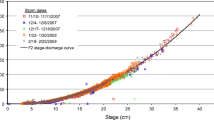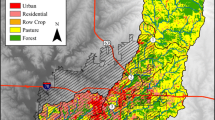Abstract
Nonpoint source pollution control requires assessment of the influence of dispersed runoff-contributing areas on downstream water quality. This evaluation must consider two separate phases: site-to-stream loading and downstream fluvial transport. Any model, combination of models, or procedure for making this assessment can be generalized to a simple spatial model or framework, which considers runoff or pollutant loading per unit area and down-stream attenuation, with drainage area as a scaling factor. This spatial model has a probabilistic interpretation and can be used in conjunction with a standard dilution model to give a probabilistic estimate of the impacts at the basin mouth of runoff from a specific upstream contributing area. It is illustrated by applying it to an assessment of the probability that various copper concentrations at the mouth of the urbanized South Platte River basin in Denver, Colorado, USA, will be exceeded as a result of runoff from a subbasin within the city. Determining the probability that a concentration of a pollutant at the basin mouth can be attributed to runoff from a discrete area within the basin is useful for targeting and risk assessment because it enables quantitative risk-based comparisons. The spatial framework is also useful for evaluating management and control options, since actions within the basin can be directly linked to water quality at a downstream point.
Similar content being viewed by others
Literature cited
Abernathy, A. R., J. Zirschky, and M. B. Borup. 1985. Overland flow wastewater treatment at Easley, S.C.Journal of the Water Pollution Control Federation 57:291–299.
Anderson, M. G., and C. C. M. Rogers. 1987. Catchment scale distributed hydrological models.Progress in Physical Geography 11:28–51.
Athayde, D. 1987.Risk assessment for nonpoint source pollution. Office of Water, US Environmental Protection Agency, Washington, DC, 12 pp.
Baker, D. B. 1985. Regional water quality impacts of intensive row crop agriculture: A Lake Erie basin case study.Journal of Soil and Water Conservation 40:125–131.
DeCoursey, D. G. 1985. Mathematical models for nonpoint water pollution control.Journal of Soil and Water Conservation 40:408–413.
Dickinson, W. T., R. P. Rudra, and D. J. Clark. 1986. A delivery ratio approach for seasonal transport of sediment. Pages 237–252in R. F. Hadley (ed.), Drainage basin sediment delivery. International Association of Hydrological Sciences, Publication 159.
Di Toro, D. M. 1984. Probability model of stream quality due to runoff.Journal of Environmental Engineering 110:607–628.
Graf, W. L. 1985. Mercury transport in stream sediments of the Colorado plateau.Annals of the Association of American Geographers 75:552–565.
Gupta, V. K.; E. Waymire, and I. Rodriquez-Iturbe. 1986. On scales, gravity, and network structure in basin runoff. Pages 159–184in V. K. Gupta, I. Rodriquez-Iturbe, C. F. Wood (eds.), Scale problems in hydrology. D. Reidel, Dordrecht.
Haimes, Y. Y., and Stakhiv, E. Z. (eds.). 1986. Risk-based decision making in water resources. American Society of Civil Engineers, New York, 333 pp.
Hammer, M. J., and K. A. Mackichan 1981. Hydrology and quality of water resources. John Wiley, New York, 486 pp.
Heatwole, C. D., A. B. Bottcher, and K. L. Campbell. 1987. Basin scale water quality model for coastal plain flatwoods.Transactions of the ASAE 30(4):1023–1030.
Judy, R. D. 1985. Enhancement of urban water quality through control of nonpoint source pollution: Denver, Colorado. Pages 247–276in J. A. Gore (ed.), The restoration of rivers and streams. Butterworth, Boston.
Knisel, W. G. (ed.). 1980. CREAMS: A field-scale model for chemicals, runoff, and erosion from agricultural management systems. Conservation Research Report 26, US Department of Agriculture, Washington, DC.
Krenkel, P. A., and V. Novotny. 1980. Water Quality Management. Academic Press, New York, 671 pp.
Lewin, J., B. E. Davies, and P. E. Wolfenden. 1977. Interaction between channel change and historic mining sediments. Pages 353–367in K. J. Gregory (ed.), River channel changes. John Wiley, New York.
Maas, R. P., M. D. Smolen, C. A. Jamieson, and A. C. Weinberg, 1987. Setting priorities: The key to nonpoint source control. Office of Water, US Environmental Protection Agency, Washington DC, 51 pp.
Marcus, W. A. 1987. Copper dispersion in ephemeral stream sediments.Earth Surface Processes and Landforms 12:217–228.
McElroy, A. D., S. Y. Chiu, J. W. Nebgen, A. Letti, and F. W. Bennett. 1976. Loading functions for assessment of water pollution from nonpoint sources. US Environmental Protection Agency, Washington, DC, 445 pp.
Noel, D. C., M. L. Terstriep, and C. A. Chenoweth. 1987. Nationwide urban runoff program data reports—Denver. Illinois State Water Survey, Champaign.
Novotny, V. 1985. Discussion.Journal of Environmental Engineering 111:737.
Novotny, V. 1986. A review of hydrologic and water quality models used for simulation of agricultural pollution. Pages 9–36in A. Giorgini and F. Zingales (eds.), Agricultural nonpoint source pollution: Model selection and application. Elsevier, New York.
Novotny, V., G. V. Simsimian, and G. Chesters. 1986. Delivery of pollutants from nonpoint sources. Pages 133–140in R. F. Hadley (ed.), Drainage basin sediment delivery. International Association of Hydrological Sciences Publication 159.
Office of Water. 1983. Results of the nationwide urban runoff program, Vols. I–III. Office of Water, US Environmental Protection Agency, Washington, DC.
Phillips, J. D. 1987. Nonpoint source pollution risk assessment and targeting: Evaluating the influence of upstream contributing areas on downstream water quality. Environmental Science and Engineering Fellowship Report, American Association for the Advancement of Science, Washington, DC, 56 pp.
Phillips, J. D. 1988. Nonpoint source pollution and spatial aspects of risk assessment.Annals of the Association of American Geographers 78:611–623.
Reckhow, K. H., J. B. Butcher, and C. M. Marin. 1985. Pollutant runoff models: Selection and use in decision making.Water Resources Bulletin 21:185–195.
Robillard, P. D., M. F. Walter, and L. M. Bruckner. 1982. Planning guide for evaluating agricultural nonpoint source water quality controls. US Environmental Protection Agency, Athens, Georgia, 733 pp.
Roesner, L. A. and S. A. Dendrou. 1985. Probability model of stream quality due to runoff: Discussion.Journal of Environmental Engineering 111:738–740.
Russell, M. and M. Gruber. 1987. Risk assessment in environmental policy-making.Science 236:286–290.
Seiler, F. A. 1986. Use of fractals to estimate environmental dilution factors in river basins.Risk Analysis 6:15–25.
Sivapalan, M., and E. F. Wood. 1986. Spatial heterogeneity and scale in the infiltration response of catchments. Pages 81–106in V. Gupta, I. Rodriquez-Iturbe, C. F. Wood (eds.), Scale problems in hydrology. D. Reidel, Dordrecht.
Smith, R. G. 1982. The overland-flow process.Environmental Progress 1(3):195–205.
Spooner, J., R. P. Maas, S. A. Dressing, M. D. Smolen, and F. J. Humenik. 1985. Appropriate designs for documenting water quality improvements from agricultural NPS programs. Pages 30–34in Perspectives on nonpoint source pollution, Office of Water, US Environmental Protection Agency, Washington, DC.
Stakhiv, E. Z. 1986. The status of risk analysis in water resources engineering. Pages 111–128in Y. Y. Haimes and E. Z. Stakhiv (eds.) Risk-based decision-making in water resources. American Society of Civil Engineers, New York.
Stoffers, P., C. Summerhayes, U. Forstner, and S. Patchineelam, 1977. Copper and other heavy metals contamination in sediments from New Bedford Harbor, Massachusetts: A preliminary note.Environmental Science and Technology 11:819–821.
Suter, G. W., II, L. W. Barnthouse, and R. V. O'Neill. 1987. Treatment of risk in environmental assessment.Environmental Management 11:295–303.
Thomas, L. 1987. Thomas talks about his goals for EPA.EPA Journal 13 (June):25–28.
Walsh, S. J. 1985. Geographic information systems for natural resource management.Journal of Soil and Water Conservation 40:202–205.
Wolfenden, P. J. and Lewin, J. 1978. Distribution of metal pollutants in active stream sediments.Catena 5(1):67–78.
Yim, W. W. S. 1981. Geochemical investigations on fluvial sediments contaminated by tin-mine tailings, Cornwall, England.Environmental Geology 3(5):245–256.
Young, R. A., C. A. Onstad, D. D. Bosch, and W. P. Anderson. 1985. A method for prioritizing water quality problem areas. Pages 368–373in Perspectives on nonpoint source pollution. Office of Water, US Environmental Protection Agency, Washington, DC.
Author information
Authors and Affiliations
Rights and permissions
About this article
Cite this article
Phillips, J.D. Nonpoint source pollution risk assessment in a watershed context. Environmental Management 13, 493–502 (1989). https://doi.org/10.1007/BF01867683
Issue Date:
DOI: https://doi.org/10.1007/BF01867683




